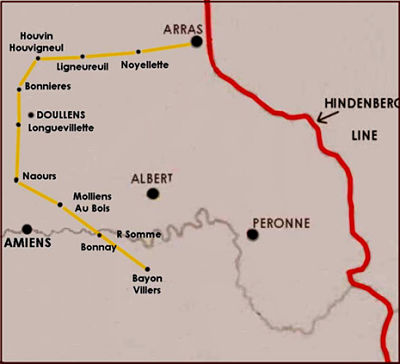
|
The 4th Yorks Battalion moved to Arras, arriving there on the 12th April.
The journey involved 9 marches, each one of 12 to 15 kilometres.
In harsh weather with a 60 pound back-pack.
Haig and Nivelles, the respective British and French commanders had planned a two pronged attack on the
German lines, designed to break through and cut them off.
The Germans had largely pre-empted this by withdrawing to the heavily defended Hindenberg
line.
In the South the French attacks were to be thrown back with such losses as to cause a
mutiny in the ranks.
At Arras, the Battle had begun on the 9th April with shelling of the German lines that
surpassed the ferocity of the Somme in the previous year.
The German front lines were shattered and the Allies at first advanced, most notably the
high ground of Vimy Ridge was taken by the Canadians.
A halt was called to consolidate and this gave the Germans time to counter-attack by bring forward Divisions that
had been held in the rear.
When the Battle was rejoined on the 23rd heavy losses were to be suffered.
Losses on average per day of this offensive were nearly twice as bad as those on the Somme.
30th MARCH TO 12TH APRIL. The Btn marched to Arras. 30th to Bonnay. 31st to Mollins au Bois. 2nd to Naour.
3rd to Longuevillette. 4th to Bonnieres. 7th to Houvin-Houvigneul. 8th to Lignereuil. 10th to Noyellette. 12th to
caves in the Faubourg Ronville, Arras.
|
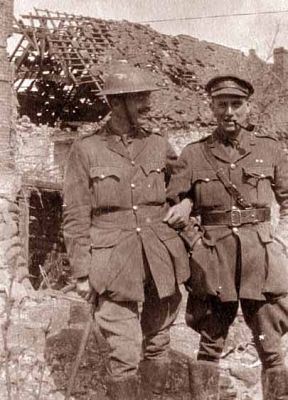 An Officer referred to on the back of the photograph as "R T", almost certainly Captain R Theakston, and Lt H N Constantine on the Right in the Arras area on April 16th 1917.
Norman Constantine was to be killed on the 27th May 1918 near Craonne in the Aisne area.
An Officer referred to on the back of the photograph as "R T", almost certainly Captain R Theakston, and Lt H N Constantine on the Right in the Arras area on April 16th 1917.
Norman Constantine was to be killed on the 27th May 1918 near Craonne in the Aisne area.
[Photo kindly contributed by Captain Constantine's Great Nephew, Simon Barnard.]
|
"The weather was rainy during the early stages and Arctic towards the end. The roads were mostly bye roads and
the going was not too easy."
[A hard task for the modern hiker. With a Rifle weighing some ten pounds and a large bayonet on the belt it was harder.
The British Army used supposedly scientific Slade-Wallace canvas webbing to distribute the rest of the 50 pound load to the shoulders and the
waist. A water bottle on the belt. A large back-pack to hold spare clothing, field dressing, iron rations and whatever small personal
items that would fit in. With often ill fitting boots and feet blistered to raw skin it was a painful and cruel march. For many it was a march
to an even more painful and cruel death or maiming.]
15TH APRIL. The 150th Brigade moved into Support in the The Harp. Here were deep dug-outs which had been
captured from the Germans in the previous week.
204112 Pte Bowes Colin, Stewart. Home at - Mount Pleasant, Arden, Helmsley, N Yorks.
Born Hornby Yorks and enlisted Thirsk, N Yorks. Died at home on the 16th. Age 19. Buried at Hawnby
[All Saints] Churchyard.
20TH APRIL. The British offensive of the 9th to 15th April, [which is called the First Battle of the Scarpe after
the river to the North] had halted. The 150th Brigade took over the newly won Front line sector on the ridge
from Wancourt Tower to the River Cojeul. The 4th Battalion were in Support in Niger Trench.
The Germans had been driven back by the surprise element and the initial bombardment, but now they were directing their
forces to plug any gap that might occur. It seems to have been the failing of attacks by both sides during the
War that, because they were carried out on foot and communication was often by runner, the Generals missed out on the
opportunity to keep advancing when the enemy was at its weakest.
21st APRIL. The Trench taken over by the 4th Btn afforded little cover and between 6 and 8 p.m German 105 and
150 mm shells caused several casualties.
Practically all the Sergeants of W Coy were knocked out and 2nd Lt Welbourne of Y Coy.
At night X Company took over the left sector of the Front line, on the R Cojeul.
W Coy were in close support
under the bank.
|
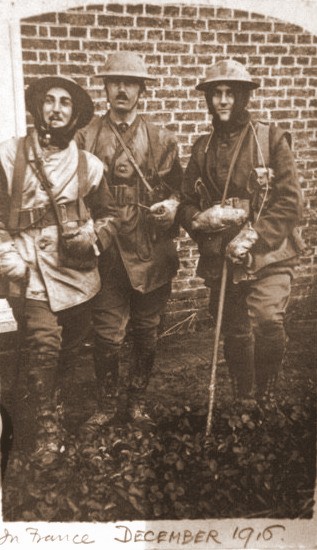
 Photograph kindly contributed by Jonathan Theakston, Great Grandson of Captain R Theakston.
Photograph kindly contributed by Jonathan Theakston, Great Grandson of Captain R Theakston.
|
[Jonathan Theakston, states that "R T" in the above photograph is almost certainly his Great Grandfather, Captain R Theakston,
who-
"went out to France in October 1916 and left the war in April 1917 after having been hit by a shell and subsequently having his
leg amputated.
He was wounded in the attacks from bank on the line from Wancourt tower to Guemappe.
He wrote a day by day, personal diary of his time which is very illuminating and great to read alongside the details of your website.
As you can imagine the movements match exactly as do mentions of those killed.
My great grandfather settled back in Masham and continued to run the family business after the war, T&R Theakston brewery, complete
with his tin leg!"
Jonathan has also contributed a section of his Great Grandfather's Diary for this period-
April 9 - Stayed in bed with strained right knee. Cast lots who should go into action and who should remain in Reserve.
April 10 - Left LIGNERUIL 3.15pm and spent the night at NOYELLETE in Nissen huts. Snowstorm.
April 12 - Left NOYELLETE 6am for ARRAS. Afternoon in caves at FAUGBORG RONVILLE, a suburb. The caves were marvellous, entered by dug out
steps, very deep, but foul atmosphere, lit by electric light (?), chalk walls and floor very wet.
Equipment and rifles got filthy. I decided to join Constantine and Taft [Quartermaster] in a cottage on top without a roof.
I had gotten a rotten headache with the caves [possibly a chill] but I preferred the fresh air to the safety of the caves.
We slept on the stone floor in our flea bags with a nice fire and a rum-jar.
April 13 or 14 - Went up with Colonel to inspect the HARP, where we had to go into Reserve.
It was a lovely day, but spoilt for us by the sight of dead cavalry horses laid all over.
Beautiful animals with glossy coats and looking tremendously fit. We had seen them passing through BONNIERES. We could also watch our
troops in action at WANCOURT - MONCHY, but could see nothing but black smoke and hear our Artillery.]
|
Y and Z Companies moved back to the Harp for the night.
Btn Hq was in a dug out in Wancourt.
150th Brigade Diary:-
Regt in left subsector , relieved 5th DLI in front system, H.Q. N.23.a.3.3. ; the latter battalion going into support in Niger Trench H.Q. N.16.d.1.6.; 5th Yorks Regt remaining in right support in Nepal trench, H.Q. at N.22.c.9.8. Reliefs were reported complete by 4am. In accordance with OC No:91 dated 20.4.17 attached 4th East Yorks in right subsector and 4th Yorks
The following 10 men were all killed in action and are buried at Hibers Trench Cemetery, Wancourt.
2nd Lt Ernest Cecil Welbourn Aged 22. He was born at Driffield in 1895. The son of Mr A H and Mrs M A Welbourn of 54 Middle Street,
Driffield. He first served in the ranks of the Royal Army Service Corps before gaining his commission. He had joined the 4th Yorks in early
1917 on the Somme.
201509 Pte Fawcett Henry. Enlisted at Richmond, N Yorks.
201498 Pte Fowler Robert, William. Home at - 157 Parliament Rd, Middlesbrough, N Yorks,
town of enlistment. Age 21.
200997 L/Sgt Hartley Maynard. Enlisted at Northallerton, N Yorks.
|
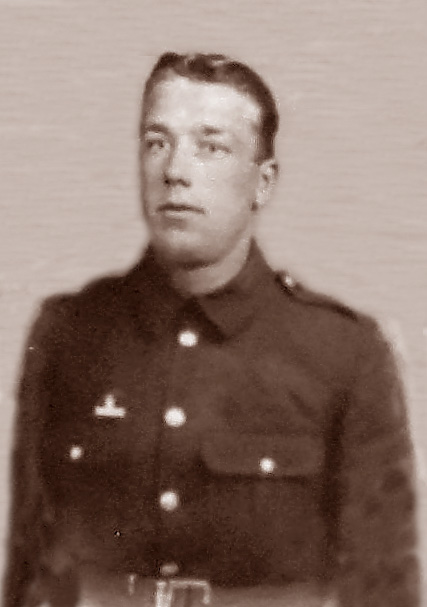 Sgt Fred Shore.MM.
Sgt Fred Shore.MM.
|
203281 Pte Kirk James. Home at - Gimmingham, North Walsham, Norfolk. Enlisted at Norwich.
Age 21.
202057 Pte Markham David, Robinson. Home at Easington Loftus Yorks and enlisted at Richmond,
N Yorks.
200195 Pte Rhodes Walter. Born at Knaresborough, Yorks and enlisted at Catterick N Yorks.
200344 Sgt Shore Fred. MM. Born and enlisted at Stokesley, N Yorks. He had been a Bricklayer before the War and had been with the 4th Yorks Battalion from the first. He was awarded the Military Medal for conspicuous bravery at
Martinpuich on the Somme in the British attack on the German trenches on the 15th Sept 1916, called the Battle of Flers
Courcelettes He was one of 7 brothers who fought in the War, 3 of whom lost their lives.
235187 Pte Spencer Edward, James. Born and enlisted at Burnley.
202268 Pte Warwick Richard, Arthur. Born and enlisted at Wellingborough Northants.
Ex Northants Regt.
|
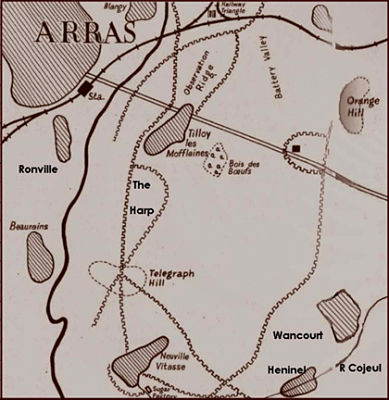
The 4th Bn stayed in caves at Ronville before moving into Support at the Harp and then on the 20th the Front line on the River
Cojeul between the villages of Heninel and Wancourt.
The villages had only just been captured from the Germans on the 12th.
|
22nd APRIL. After giving the Germans a week to consolidate, Sir Douglas Haig decided to continue the offensive
and the Second Battle of the Scarpe was planned to commence next day.
He said in his despatches -"My task was to
attract as large hostile forces as possible to my Front before the French offensive was launched.....I did not consider
that any great strategical results were likely to be gained to South of it beyond the capture of the objectives aimed
at."
It appears from this that the Infantry battalions involved were pawns to be sacrificed in the chess games played out
in the safety of the French chateaux miles behind the carnage.
The new offensive was to be carried out over a 9 mile front and the 50th Division was given objectives ahead of Wancourt.
The attack was to be made by the 150th Brigade with the 4th East Yorks on the right and 4th Yorks on the left. Each
Btn keeping one Company in Support.
Bde Diary - By 10pm H.Q. of 4th Yorks Regt and 4th East Yorks had been transferred to N.24.c.0.5.
The following 3 men died of wounds on the 22nd and are buried at Warlincourt Halte British Cemetery, Saulty.
201684 Pte Hindmarsh William. Born 1875 in Great Ayton, Yorks. 1891 A farm servant at Mount Pleasant, Little Stainton. 1901 agricultural labourer, age 26, with 3 children at Grange Cottage, Piercebridge.
1911 Farm Labourer with 6 children at Morton Carr, Nunthorpe, N Yorks. Recorded as Hindmarch.
200092 Sgt Rogowski Arnold, Fred. Born and enlisted at Middlesbrough, N Yorks.
Age 22.
|
235192 Pte Thompson Joseph Heyns Home at 29 Parton St, Fairfield, Liverpool,
place of birth and enlistment. Age 28.
|
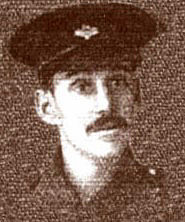 Sgt John R Ellis.
Sgt John R Ellis.
|
200028 Sgt Ellis John Home at Morningside, Quaker Lane, Northallerton, N Yorks,
place of enlistment. Born at Stockton on Tees. Killed in action. Age 26. Commemorated on the Arras Memorial.
He was married, but his wife appears to have re-married after his death as she is listed as Mrs. E. Wood (formerly Ellis).
He had two sons, William and John.
Before the War, he worked for the North Eastern Railway as a Joiner in the Engineers Department at Northallerton.
He was also a member of the local Territorial Battalion before the outbreak of War and sailed with them to France in April
1915.
He was wounded in April/May at Ypres and invalided home, but recovered from his injuries and returned to France only a
couple of months before the fateful attack which was to claim his life.
[Photo and information courtesy of - Northallerton Memorials
Project.]
|
|



